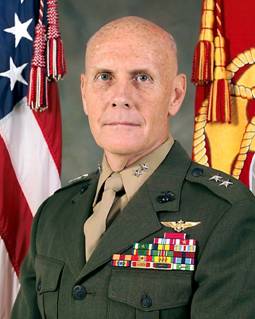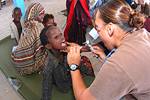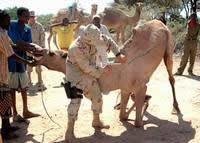18/01/06 (B333-B) Selon une déclaration du 2 janvier 2006 largement diffusée, y compris sur le site US de la Défense, le général des Marines Timothy Ghormley, commandant la Task Force à Djibouti estime que les troupes américaines viennent en aide aux populations tandis que les militaires français utilisent leurs armes pour tuer des hyénes. (On ne peut être plus aimable pour les militaires français … ! mais c’est Guelleh qui choisit ses amis !) (Texte français et anglais)
_______________________________ Français

Djibouti : les soldats américains s’efforcent d’améliorer le sort de la population
Ils apportent leur concours aux projets mis sur pied par l’USAID.
|
Les forces US ne soignent pas que les humains … |
Cet article a été publié pour la première fois par le service de presse des Forces américaines et affiché le 3 janvier 2006 sur le site web du ministère de la défense. Il peut être reproduit librement. |
Camp Lemonier, Djibouti –
Si les militaires qui se trouvent sur l’un des fronts importants de la guerre mondiale contre le terrorisme se battent avec acharnement, ce n’est pas avec des armes.
 |
« Nous ne ménageons aucun effort pour la paix », a déclaré le commandant du Corps expéditionnaire combiné pour la Corne de l’Afrique (« Combined Joint Task Force-Horn of Africa, CJTF-HOA ») du Camp Lemonier à Djibouti, le général des Marines Timothy Ghormley, le 2 janvier, au Service de presse des forces américaines, ajoutant que ses soldats n’avaient jamais été contraints à tirer un seul coup de fusil pour se défendre. « Un jour, les Français, eux, ont dû tuer une hyène », a-t-il souligné, ajoutant que le personnel militaire sous son commandement – Marines, aviateurs, marins et soldats – œuvraient au renforcement et à la stabilisation des pays de la région. |
« Nous mettons en place les conditions pour la victoire. Nous évitons une répétition de ce qui se passe en Irak ou en Afghanistan », a-t-il dit.
Le Corps expéditionnaire a son quartier général au Camp Lemonier, mais ses activités couvrent le Yémen, l’Érythrée, l’Éthiopie, le Soudan, le Kenya et l’Ouganda. La Somalie tombe aussi sous la responsabilité du commandement, mais il n’y est pas actif. La région est immense ; elle représente en gros un tiers de la superficie des États-Unis et a 167 millions d’habitants.
Le général Ghormley ne doute pas que l’organisation terroriste Al-Qaïda est active en Somalie et que l’organisation terroriste aimerait exporter sa philosophie vers la région d’Ogaden, qui comprend l’est de l’Éthiopie, Djibouti et une partie du Kenya, ainsi que le long de la côte swahilie, vers le Kenya, mais les activités des soldats américains dans la région l’empêchent de s’y établir.
« Si nous n’étions pas là, assure-t-il, ils y seraient. J’ignore ce qu’ils font (Al-Qaïda en Somalie), mais j’aurais du mal à croire que ce soit de bonnes choses. ».
La région d’Ogaden figure en bonne place dans la stratégie du commandement. La région est déserte et livrée à elle-même. Elle est très pauvre, et le danger y est tel que l’Agence des États-Unis pour le développement international (USAID) n’y maintient aucune présence, une situation qui ne rebute pas les Marines, qui, a expliqué le général, « vont là où le danger existe ».
Tous les soldats qui quittent le camp sont armés, mais la règle d’engagement est stricte : s’en servir uniquement en cas de légitime défense. Une fois que les militaires ont en quelque sorte « ouvert la voie », l’USAID peut venir travailler.
« Nous entretenons d’excellentes relations de travail avec l’USAID », a affirmé le général. « L’impact, c’est nous ; la durabilité, c’est eux. Nous construisons une école ; ils fournissent les enseignants et les livres. »
Les militaires veillent à changer les impressions de la population et à la convaincre que les États-Unis ne sont pas en guerre avec l’islam. « Nous sommes en guerre avec ceux qui se serviraient d’une idéologie terroriste pour s’attaquer à notre mode de vie », a-t-il expliqué, précisant que la mission du Corps n’était pas la lutte armée, mais « d’influencer l’opinion des gens grâce à notre présence ».
L’eau est l’un des moyens d’y parvenir dans l’Ogaden, et un petit village situé à proximité de Gode, pratiquement au centre de la région, en a fourni l’occasion. « Une couche de poussière de 15 cm recouvrait les rues. Il n’avait sûrement pas plu depuis trente ans », a fait remarquer le général.
Les villageois voulaient une pompe pour les aider à tirer de l’eau de la rivière et acheminer cette eau jusqu’à leurs champs. « Le sergent Chuck McDermott, de l’armée de terre, est allé acheter une pompe de 14 chevaux et en a fait don aux villageois », a ajouté le général.
Ce sont ces derniers qui ont fait les plans du projet d’irrigation et qui ont installé les tuyaux. Aujourd’hui, ils ont 15 hectares de terres irriguées. Le maïs qu’ils ont planté en octobre a trois mètres de haut environ. Le groupe a établi une coopérative et se réserve la moitié de la récolte pour sa consommation et l’autre pour la vente.
La remise en état d’un hôpital à Jijiga, la principale ville de la région, est un autre projet auquel travaillent les militaires américains. Construit en 1945, l’établissement n’avait jamais été modernisé. La réfection d’une salle réservée aux futures mamans et l’installation de l’eau courante dans l’hôpital sont prévues. « Les gens du coin pensaient que c’était un miracle et que grâce à nous l’hôpital était réparé », a expliqué le général.
Tout ce travail est accompli à bon compte. Les militaires prodiguent des soins médicaux, dentaires et vétérinaires à divers endroits de la région. Ils creusent des puits, construisent des ponts, remettent en état des écoles et des dispensaires ou en construisent. Ils pourraient faire plus mais, a fait valoir le général, « mon budget n’est que de 15 millions de dollars par an, c’est peu ».
De l’avis de ce dernier, si les États-Unis ont une responsabilité à l’égard de leurs concitoyens, ils en ont une également à l’égard des gens de la région.
« Je dis à ceux qui viennent d’être affectés ici que nous ne sommes pas meilleurs que les gens de la région, que nous sommes seulement mieux lotis. Ainsi, nous avons la responsabilité d’aider la population locale à progresser, à passer de la simple subsistance à la capacité de subvenir à leurs propres besoins », a conclu le général.
___________________________________ Anglais
Communiqué du Département US de la Défense, le 3 janvier 2006
![]()

U.S. Servicemembers ‘Waging Peace’ on Horn of Africa
By Jim Garamone
American Forces Press Service
CAMP LEMONIER, Djibouti, Jan. 3, 2006 –
Servicemembers on an important front in the global war on terror are fighting hard, but not with weapons.
"We’re waging peace as hard as we can," the commander of Combined Joint Task Force Horn of Africa told American Forces Press Service Jan. 2 here.
Marine Maj. Gen. Timothy Ghormley said the command has not had to fire a shot in anger. "The French had to kill a hyena once," he said.
He said Marines, airmen, sailors and soldiers in the command are strengthening and stabilizing the nations of the region.
"We are setting the conditions for victory," the general said. "We’re avoiding another Iraq or Afghanistan."
The joint task force has its headquarters here, but it operates in Yemen, Eritrea, Ethiopia, Sudan, Kenya and Uganda. Somalia is in the command’s area, but the command does not operate there. The area is huge, roughly a third of the size of the continental United States, with a total population of 167 million people.
Ghormley said he understands al Qaeda is active in Somalia, and he imagines the terror organization would like to export its philosophy to the Ogaden area – an area of Eastern Ethiopia, Djibouti and parts of Kenya – and down the Swahili coast toward Kenya. The U.S. effort in the region stops al Qaeda from establishing a presence.
"If we weren’t there, they would be," the general said. "I can’t imagine what’s going on (in Somalia by al Qaeda), but I can’t imagine it is good."
The Ogaden figures prominently in the command’s strategy. The area is desolate and largely ungoverned. It’s very poor, and the threat in the region is such that the U.S. Agency for International Development does not go in there. "We go into the ungoverned spaces," Ghormley said. "We go where there is a threat."
Every troop who leaves this camp is armed. But the rules of engagement are strict: self-defense only. Once the servicemembers are in the door, so to speak, USAID can follow.
"We have a very good working relationship with USAID," Ghormley said. "We provide the impact, they provide the sustainability. We build a school; they provide the teachers and the books."
The command is trying to change the residents’ impressions, and convince them that the United States is not at war with Islam. "We are at war with those who would use a terrorist ideology to attack our way of life," the general explained.
Ghormley said combat is not the task force’s mission. "I have no direct-action mission. I have no kinetic mission. I do not have a mission to seek out and destroy," he said. "My mission is to influence the people’s opinion through our presence."
Water was one way to do that in the Ogaden. The general said a small hamlet outside Gode – almost directly in the center of the area – provided an opportunity.
"These people walked through six inches of dust," Ghormley said. "It probably hasn’t rained there for 30 years."
The villagers wanted a pump to help them get water from the river to their fields. "Army Staff Sgt. Chuck McDermott went out and bought a 14-horsepower pump and gave it to them," the general said.
The villagers designed the project and laid the pipes. They now have 15 hectares of irrigated land. Their corn, planted in October, is about three feet high. The group formed a co-op, and is reserving half of the crop to eat and half to sell.
Another program in the Ogaden was a hospital refurbishment in Jijiga, the chief city of the region. The hospital was built in 1945 and has not rehabilitated since. The command will work on a "mother-child" ward and also to get running water to the hospital. "The people there thought it was a miracle that we came in and fixed the hospital," Ghormley said.
The command "does things on the cheap," Ghormley said. Troops provide medical, dental and veterinary care at various places throughout the region. The troops drill wells, build bridges, refurbish or build schools and clinics. And they could do more. "I have a $15 million a year budget, which is pennies," he said.
The United States has a responsibility to its own citizens, but also to those in the region, Ghormley said. "I tell people when they get assigned here that we’re not better (than the people of the region), we’re better off," he said. "And with that comes a responsibility to help lift the people of the region from just a level of existence to a level of subsistence – where they can provide for themselves."
___________________________________________ Carrière du Général
Major General Timothy F. Ghormley
Commander, Combined Joint Task Force Horn of Africa, U.S. Central Command
MajGen Ghormley is currently serving as Commander, Combined Joint Task Force Horn of Africa, United States Central Command. He assumed this command on May 17, 2005.
MajGen Ghormley entered the Marine Corps in April 1967. During his enlistment he served with 1st Force Troops, 1st Redeye Platoon, 29 Palms, Calif. and in Vietnam with 2d Battalion, 4th Marine Regiment and the 3d Combined Action Group.
MajGen Ghormley was discharged from active duty and entered college in 1970. He became a member of the Platoon Leaders Course Program and in 1973 he received his bachelors degree from CSUSD and his commission as a 2ndLt. After TBS and flight training, MajGen Ghormley was transferred to VMFP-3 at MCAS El Toro, Calif. In June 1980 MajGen Ghormley was ordered to Amphibious Warfare School.
In 1981 he returned toVMFP-3. In 1985 he attended Marine Corps Command & Staff College. In 1986 he transitioned to the F/A-18 Hornet and served as the Marine Liaison Officer with the U.S. Navy LSO School. In 1988, MajGen Ghormley was transferred to VMFA-122, MCAS Beaufort SC as the squadron executive officer. In July 1990, Major General Ghormley transferred to NAS Lemoore, Calif. where he served as Executive Officer VFA-125. In July 1991 he attended the Naval War College, Newport, R.I.
In 1992 he transferred to MCAS Kaneohe Bay, Hawaii, and assumed command of VMFA-212. In April 1, 1994 MajGen Ghormley assumed duties as Command Duty Officer, USCINCPAC, Camp Smith, Hawaii.
In July 1996, he assumed command of MAG 49. MajGen Ghormley relinquished command on July 12, 1998 and was reassigned to the office of the CNO (N-880M). He was selected to BGen in March 1999 and assumed the duties as Assistant Deputy Chief of Staff for Manpower and Reserve Affairs (Reserve Affairs) on June 14, 1999. On September 13, 1999, MajGen Ghormley assumed duties as the Inspector General of the Marine Corps, Washington, D.C.
On July 1, 2001, MajGen Ghormley assumed the duties of Commanding General, 3D Marine Expeditionary Brigade; Deputy Commanding General III Marine Expeditionary Force, Okinawa, Japan. During this assignment he also commanded the Expeditionary Strike Group, U.S. Seventh Fleet and was designated a “Plank Owner” of the ESG. On July 28, 2003, he assumed his previous assignment as Director, Manpower Plans & Policy Division, Headquarters, U.S. Marine Corps.
(Revised January 9, 2006
L’arsenal de guerre américain à Djibouti :



